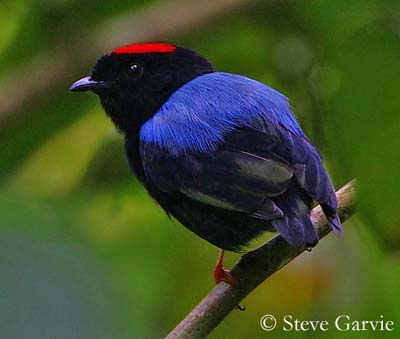
Blue-backed Manakin
Chiroxiphia pareola
Passeriforme Order - Pipridae Family
BIOMETRICS:
Length: 12-14 cm; Weight: 17-21 g
LONGEVITY : up to 14 years
DESCRIPTION:
Blue-backed Manakin is a small compact bird, living in tropical South America.
Blue-backed Manakin adult male has pale blue back and scapulars. The rest of the plumage is black. Tail is very short, giving very compact silhouette.
On the black head, we can see a bright red crown patch. Male has small black frontal crest.
Thin, sharp bill is black. Eyes are deep reddish-brown. Legs and feet are orange-red.

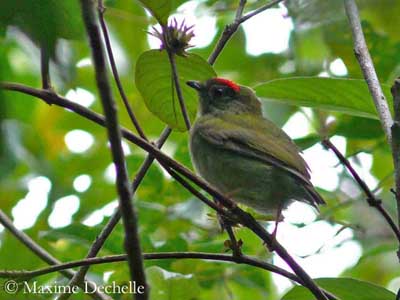
Female is very different with olive-green plumage on the upperparts. On the underparts, throat is paler and yellower. Belly and undertail coverts are yellowish-white. Legs are duller than in male, mostly flesh-coloured. Bill is paler too.
Juvenile is similar to female.
Immature has some intermediate plumages, first for the red crown patch, and little by little, it acquires the blue back feathers.
We find four subspecies:
C.p. napensis, smaller, with brighter red crown patch and darker blue back.
C.p. regina, with golden-yellow crown patch.
C.p. atlantica is heavier with weight of 20 to 25 gr, and it has more extended blue back. It is endemic to Tobago.
C.p. pareola has blue back feathers which taper to a point towards the rump.
VOICE: SOUNDS BY XENO-CANTO
Blue-backed Manakin’s call is a rolling “churrrr-chup” or a “whee-wher”, used as advertising call. We can also hear some “coo-ee”.
During the jump displays, the male utters vibrant or buzzing notes at increasing speed “arrrrr…” ending in loud “zeek-eek”. This song is given by the dominant male. Males may also perform duets such as series of “chup” notes.
HABITAT:
Blue-backed Manakin frequents humid forest and second growth woodland, with abundant undergrowth.
It occurs in drier forest and scrubby woodlands in some parts of the range.
It is found from the lowlands up to 500 metres of elevation, and locally up to 700 metres.
RANGE:
Blue-backed Manakin is probably sedentary in its range. It is found in the tropical regions of South America, in southern Colombia, eastern Venezuela, the Guianas, north-eastern Brazil and the Amazon basin, and also in Tobago. An isolated population lives in the south-eastern coast of Brazil, over 3000 km length.
BEHAVIOUR:
Blue-backed Manakin performs aerial sallies from foliage for catching insects and spiders. It also feeds on fruits plucked in rapid flights from close perch. Then, it lands with the fruit in the bill and swallows it whole.
Blue-backed Manakin performs spectacular displays during breeding season. Several males display at particular grounds or leks where mating takes place.
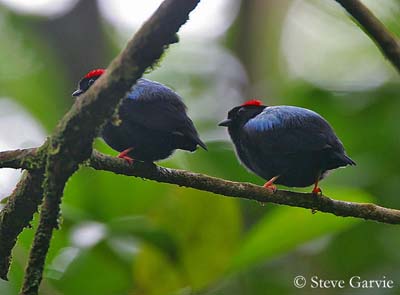
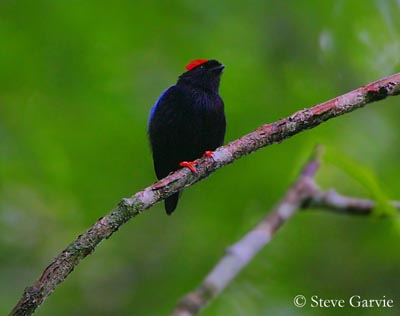
The Blue-backed Manakins have cooperative rather than competitive displays. These displays occur on slender, slightly bowed stems or branches, at about 1, 50 metres above the ground, in the undergrowth of the forest.
Each “mating perch” has one dominant male with some subordinate males. The Blue-backed Manakin’s courtship displays include four parts.
First, males perform duets. The dominant male is perched near its mating place and calls regularly until one of its subordinates joins it.
Both birds perch side by side, very close to each other and turned in the same direction. They begin a loud duet, first the dominant, followed by the subordinate, giving a ringing sound.
Then, both birds fly down to the perch, in order to perform the jumping displays. The birds are crouched and then, they jump with fluttering wings and bill pointed downwards, while legs hang before to land onto the perch. During the jumps, the Blue-backed Manakins utter vibrant calls with the bill wide open.
The two birds jump side by side and alternately. Little by little, the jumps become lower and more active, and the calls become confused. At the end of the last jump, we can hear a louder note, followed by high-pitched notes. Then, both birds fly off.
The third part is performed when a female arrives at the mating perch. Both males turn to face her. The first male jumps up, hovering in the air always facing the female, and still hovering, it moves backwards, while the second male takes its place and jumps. Finally, both males perform circles by jumping facing the female, and always uttering the vibrant notes ending by the sharp “zeek”.
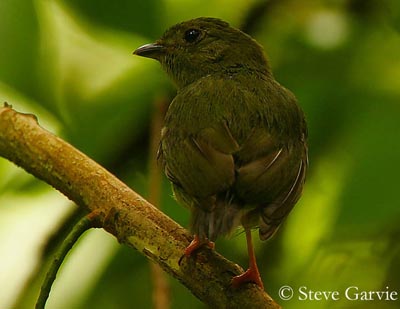
This note is given by the dominant male and means that its dancing partner has to leave the place. The last part of the display is pre-copulatory.
The dominant male flutters around the female with a kind of butterfly-like flight, alighting briefly on the display perch and flying off again. When it alights close to the female, it crouches in front of her and displays the blue back feathers while its wings are vibrating. The red crown patch is displayed too as it bows the head. After some short flights more, the male finally flies to the mating perch and the copulation occurs.
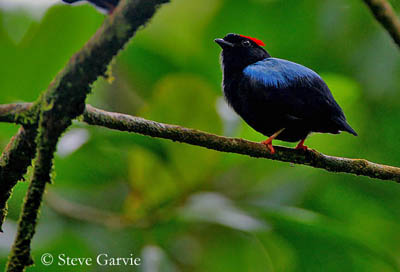
Only the dominant male can mate with a female. Subordinates are younger and are gaining experience by displaying with it. When the oldest male looses its status, a younger male takes its turn.
FLIGHT:
Blue-backed Manakin has agile flight, performing hovering during courtship displays and other varied flights and jumps.
REPRODUCTION:
Breeding season varies according to the region.
Nest is situated in a tree and built by the female. It is a small cup made with plant materials such as fibres, leaves, fine rootlets and often suspended in a small fork between two twigs. It is secured with spiders’ webs and fine rootlets. The nest is often invisible, perfectly camouflaged into the vegetation.
The male does not participate in nesting duties.
Female lays 2 brown eggs with white markings. Incubation lasts about 17 to 20 days, by female alone. Chicks are fed mainly with insects and small fruits. They leave the nest about two weeks after hatching, but they are still fed during several weeks by the female.
DIET:
Blue-backed Manakin feeds on insects and small fruits.
PROTECTION / THREATS / STATUS:
Blue-backed Manakin is common to locally common according to the region. This species is not threatened at this moment.
Fr: Manakin tijé
All : Prachtpipra
Esp : Saltarín Dorsiazul
Ital : Manachino dorsoblu
Nd : Prachtmanakin
Photographs by Steve Garvie
His website : RAINBIRDER Photo galleries
Photograph of the first female by Maxime Dechelle
His website :
LEPAPARRAZO
Text by Nicole Bouglouan
Sources :
HANDBOOK OF THE BIRDS OF THE WORLD Vol 9 - by Josep del Hoyo - Andrew Elliot - David Christie - Lynx Edicions - ISBN: 8487334695
Arthur Grosset's Birds (Arthur Grosset)
Birds in Suriname, South America (Jan Hein Ribot)
Wikipedia (Wikipedia, The Free Encyclopedia)